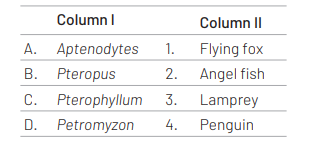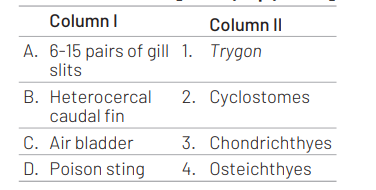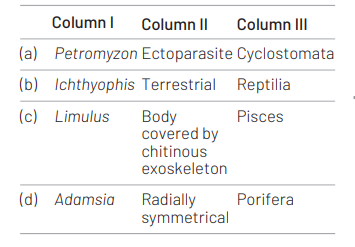Question
Match the following columns and select the correct option from the codes given belows. [NEET (Oct.) 2020]

Codes
A B C D
(a) 3 4 2 1
(b) 3 4 1 2
(c) 4 1 2 3
(d) 2 1 4 3
Answer/Explanation
Ans. (c)
The option (c) is the correct match which is as follows
Aptenodytes is penguin
Pteropus is flying fox
Pterophyllum is angel fish
Petromyzon is lamprey
Question
115 Match the following columns and select the correct option. [NEET (Sep.) 2020]
$\begin{array}{llll}A & B & C & D\end{array}$
(a) $3 \quad 4 \quad 1 \quad 2$
(b) $\begin{array}{llll}4 & 2 & 3 & 1\end{array}$
(c) $1 \quad 4 \quad 3 \quad 2$
(d) $2 \quad 3 \quad 4 \quad 1$
Answer/Explanation
Ans. (d)
Option (d) is correct. It can be explained as follows
Cyclostomes have an elongated body bearing 6-15 pairs of gill slits for respiration. Air bladder is present in bony fishes belonging to
class-0steichthyes which regulates buoyancy.
Trygon, a cartilaginous fish, possesses poison sting.
Heterocercal caudal fin is present in members of class-Chondrichthyes.
Question
Which of the following characteristic features always holds true for the corresponding group of animals? [NEET 2016, Phase I]
(a) Viviparous Mammalia
(b) Possess a mouth Chordata with an upper and a lower jaw
(c) 3-chambered heart Reptilia with one incompletely divided ventricle
(d) Cartilaginous – Chondrichthyes endoskeleton
Answer/Explanation
Ans. (d)
Reptiles have 3-chambered heart except crocodiles. Mammals are viviparous except prototherian mammals; chordates have jaws except protochordates and cyclostomes.
Question
A jawless fish, which lays eggs in fresh water and whose ammocoetes larvae after metamorphosis return to the ocean is [CBSE AIPMT 2015]
(a) Eptatretus
(b) Myxine
(c) Neomyxine
(d) Petromyzon
Answer/Explanation
Ans. (d)
Petromyzon (the lamprey) belongs to the section Agnatha of the
subphylum-Vertebrata. They have long, greenish brown, cylindrical body with smooth scaleless, slimy skin, jawless mouth, etc. They lay eggs in freshwater, but their ammocoete larvae (lower) after metamorphosis return to the ocean.
Question
A marine cartilaginous fish that can produce electric current is [CBSE AIPMT 2014]
(a) Pristis
(b) Torpedo
(c) Trygon
(d) Scoliodon
Answer/Explanation
Ans. (b)
Torpedo is a marine cartilaginous fish which produces 8-220 volt electric charge (current) depending on species.
Their electric organs are modified lateral muscle plates innervated by cranial nerves.
Trygon(sting ray) resembles electric ray in many aspects but is devoid of electricity discharging (or producing) organs.
Scoliodon (dog fish) is known for its great sense of smell.
Pristis or common saw fish (also known as carpenters shark) is characterised by a long, narrow, flattened rostrum lined with sharp transverse teeth to resembles a saw.
Question
Match the name of the animal (column I) with one characteristics (column II) and the phylum/class (column III) to which it belongs [NEET 2013]

Answer/Explanation
Ans. (a)
Option(a) is correctly matched as
Petromyzon(lamprey) is an ectoparasite on fishes, which belongs to
Cyclostomata. Other can be corrected
as Ichthyophis is a limbless amphibian.
Limulus (king crab) is a living fossil,
which belongs to Arthropoda. Adamasio having polyp body form is a coelenterate.
Question
Which one of the following groups of animals is correctly matched with its one characteristic feature without even a single exception? [CBSE AIPMT 2011]
(a) Chordata – Possess a mouth provided with an upper and a lower jaw
(b) Chondrichthyes – – Possess cartilaginous endoskeleton
(c) Mammalia – Give birth to young ones
(d) Reptilia – Possess 3-chambered heart with one incompletely divided ventricle
Answer/Explanation
Ans. (b)
The members of class-Chondrichthyes are marine animals with streamlined body and have cartilaginous endoskeleton.
Chordata These possessing a notochord, a hollow dorsal nerve cord, pharyngeal slits, an endostyle and a post and tail for atleast some period of their life cycle.
Mammalia These are a clade of endothermic amniotes distinguished from reptiles and birds by the possession of hair, three middle ear bones, mammary glands, and a neocortex.
Reptile These are an evolutionary clade of animals, comprising today’s turtles, crocodilians, snakes, lizards and tuatara, their extinct relatives and some of the extinct ancestors of mammals.
Question
What will you look for to identify the sex of the following? [CBSE AIPMT 2011]
(a) Male frog – A copulatory pad on the first digit of the hindlimb
(b) Female – Anal cerci cockroach
(c) Male shark – Claspers borne on pelvic fins
(d) Female – Sharply curved Ascaris posterior end
Answer/Explanation
Ans. (c)
A clasper is a male anatomical structure found in some groups of animals and used in mating. Male cartilaginous fish like shark have claspers formed from the posterior portion of their pelvic fin which serves as intermittent organs used to channel semen into the female’s cloaca during mating.
Question
Which one of the following pairs of animal comprises jawless fishes’? [CBSE AIPMT 2009]
(a) Lampreys and eels
(b) Mackerals and rohu
(c) Lampreys and hag fishes
(d) Guppies and hag fishes
Answer/Explanation
Ans. (c)
Lampreys and Myxine (hag fish) belong to the class-Cyclostomata,
group-Agnatha of Vertebrata. Agnatha have mouth without jaws. In these, mouth is ventral, suctorial and circular.
Question
Which one of the following is an exotic Indian fish? [CBSE AIPMT 1996]
(a) Catia catla
(b) Heteropneustes fossilis
(c) Cyprinus caprio
(d) Labeo rohita
Answer/Explanation
Ans. (c)
Cyprinus caprio is the exotic breed. It is also known as common carp. It is a widespread fresh water fish of eutrophic water lakes and rivers in Europe and Asia.
Question
Fish which can be used in biological control of mosquitoes/larvicidal fish is [CBSE AIPMT $1989,99,2001]$
(a) eel
(b) carp
(c) cat fish
(d) Gambusia
Answer/Explanation
Ans. (d)
Gambusia (mosquito fish) eats the larvae of mosquito, so it is used in biological control of mosquito.
